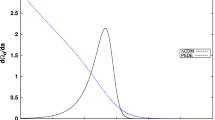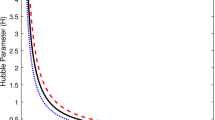Abstract
A specific class of singularity-free cosmological model has recently been considered in light of different observational data such as observed Hubble data, BAO data from luminous red galaxy survey by Slowan digital sky survey (SDSS) and CMB data from WMAP. However, it is observed that only 12–14 data points are used to study the viability of the model in late time. In this paper, we discuss the viability of all the models belonging to the same class of EU in light of union compilation data (SNIa) which consists of over a hundred data points, thus getting a more robust test for viability. More importantly, it is crucial that we can distinguish between the various models proposed in the class of solution obtained. We discuss here why with the present observational data it is difficult to distinguish between all of them. We show that the late-time behaviour of the model is typical to any asymptotically de Sitter model.



Similar content being viewed by others
References
Riess et al, Astron. J. 116, 1009 (1998)
S Perlmutter et al, Nature 51, 391 (1998)
S Perlmutter et al, Astrophys. J. 517, 565 (1999)
S Perlmutter et al, Astrophys. J. 598, 102 (2003)
E R Harrison, Mont. Not. R. Aston. Soc. 69, 137 (1967)
G F R Ellis and R Maartens, Class. Quant. Grav. 21, 223 (2004)
S Mukherjee et al, Class. Quant. Grav. 23, 6927 (2006)
J C Fabris et al, Phys. Lett. A 367, 423 (2007)
A Banerjee, T Bandyopadhyay and S Chakraborty, Gen. Rel. Grav. 40, 1603 (2008)
U Debnath, Class. Quant. Grav. 25, 205019 (2008)
B C Paul and S Ghose, Gen. Rel. Grav. 42, 795 (2010)
S del Campo, R Herrera and P Labrana, J. Cosmol. Astropart. Phys. 30, 0711 (2007)
B C Paul, P Thakur and S Ghose, Mon. Not. R. Astron. Soc. 407, 415 (2010)
B C Paul, S Ghose and P Thakur, Mon. Not. R. Astron. Soc. 13, 686 (2011)
S Ghose, P Thakur and B C Paul, Mon. Not. R. Astron. Soc. 20, 421 (2012)
P Thakur, Pramana – J. Phys. 89, 27 (2017)
P Thakur, Pramana – J. Phys. 88, 51 (2017)
R Amanullah et al, Astrophys. J. 716, 712 (2010)
S Nesseris and L Perivolaropoulos, J. Cosmol. Astropart. Phys. 0701, 018 (2007)
Acknowledgements
SG is thankful to SIEM, Siliguri and IRC, University of North Bengal for providing research support.
Author information
Authors and Affiliations
Corresponding author
Rights and permissions
About this article
Cite this article
Ghose, S. On distinguishing different models of a class of emergent Universe solutions. Pramana - J Phys 90, 43 (2018). https://doi.org/10.1007/s12043-018-1535-z
Received:
Revised:
Accepted:
Published:
DOI: https://doi.org/10.1007/s12043-018-1535-z




